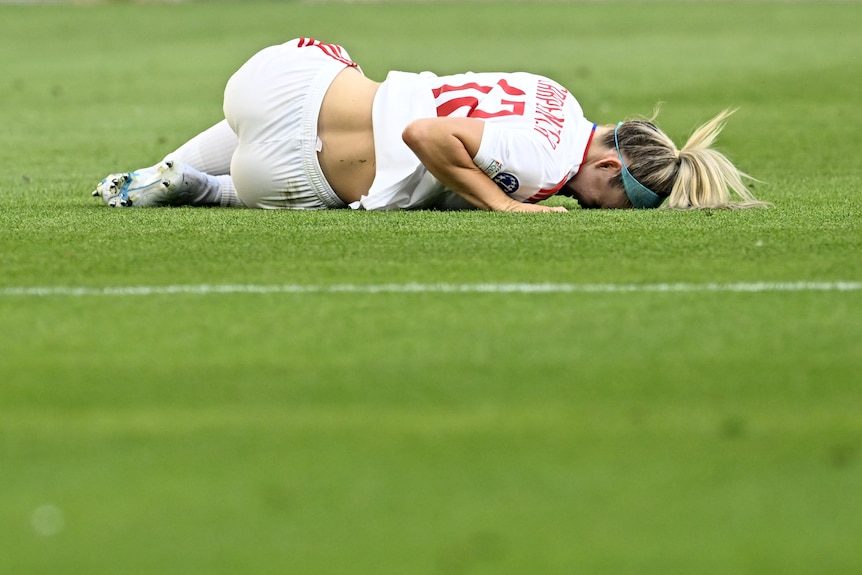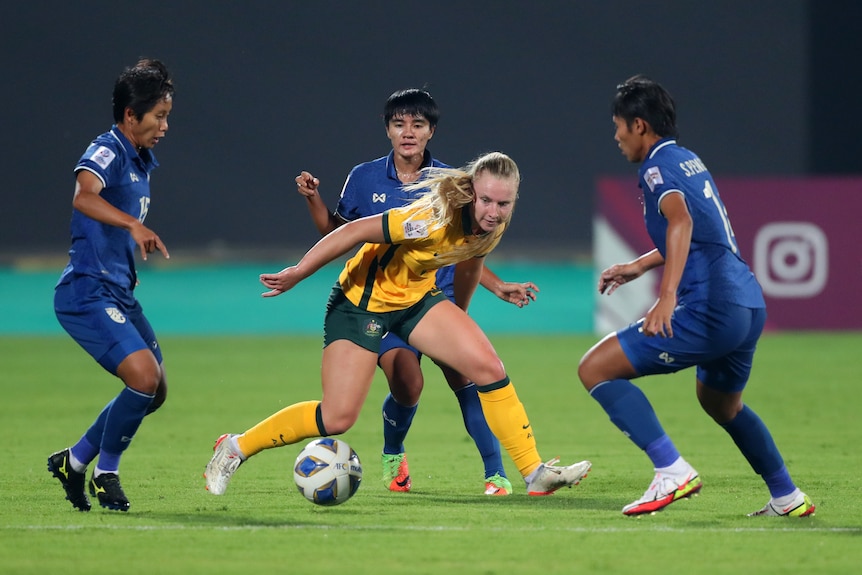This weekend, when Melbourne City take on Sydney FC in the 2023-24 A-League Women (ALW) grand final, three players will be watching and cheering on their teammates from the sidelines.
City forward Holly McNamara and Sydney defenders Natalie Tobin and Kirsty Fenton suffered ACL injuries this season, keeping them out of action for between six months and a year.
They join six other footballers from various ALW clubs in the stands as the season draws to a close, bringing the league’s total ACL injury list to nine.
Like many other professional women’s leagues around the world, Australia’s top competition has been significantly affected by what players have anecdotally described as an “epidemic” of ACL injuries.
Female athletes are between two and six times more likely than men to suffer an ACL injury while training or playing their sport – a figure that has not improved despite the rapid professionalisation of women’s football in recent years.
With more and more high-profile footballers such as Sam Kerr, Beth Mead, Vivianne Miedema, Marie-Antoinette Katoto, Leah Williamson, Janine Beckie, Delphine Cascarino and dozens more internationals forced to miss major tournaments in the last two years due to the ACL breaks, while losing valuable income along the way; The calls to action have become louder.
FIFPro, the global players’ union, has finally heeded this call.
Today, the union launched an innovative new program titled “Project ACL” that aims to address the many interrelated factors that put female soccer players at higher risk of tearing their anterior cruciate ligament.
The three-year study will review existing research on ACL injuries in female athletes, conduct evaluations of the resources and structures provided by participating Women’s Super League (WSL) clubs in England, and implement its own digital tool that tracks the WSL players’ playing workload, travel time and high-intensity match minutes in real time, generating more complete and nuanced data on the circumstances in which female footballers are most at risk.
While research on ACL injuries in women’s sport continues to flourish, what makes the FIFPro program revolutionary is combining academic work (which has primarily focused on the internal biological and physiological factors of amateur athletes ) with a broader evaluation of the external environments in which players play, train and practice. , recover and travel.
As with all sports, resources differ from club to club, and women’s teams that are supported by larger, wealthier men’s clubs are likely to have access to better resources, such as qualified staff, gyms, recovery centers and programs. , nutrition and private or commercial services. class trips compared to teams that receive less support.
However, there is simply not enough research on these environmental factors to determine which are the most important and which can be modified by clubs, coaches and staff in ways that prevent future injuries.
“This research has never been done before,” said Dr Alex Culvin, Head of Strategy and Research for Women’s Football at FIFPro.
“It’s a collaborative project between stakeholders, which hasn’t been done before either: we have four major stakeholders (FIFPro, the England Players’ Union, Leeds-Beckett University and Nike) coming together to better understand football injuries. anterior cruciate ligament, as well as the environments and conditions in which they occur.
“This project is a response to players who are rightly calling for more research: it is about centralizing the needs of players and their voice, but also moving away from singular or binary interpretations of ACL injuries.
“(Rather than) just pointing out ‘workload’ or ‘female physiology,’ one of the main goals of this project is to understand the holistic risk factors, the environmental risk factors, and that fundamentally comes down to the conditions in which the players play.
By partnering with WSL clubs, they will allow FIFPro researchers access to their facilities to assess aspects such as access to teams and facilities, team size, staff-to-player ratios, budgets, programs, playing schedules and performance data, the union hopes to produce a more holistic understanding of why ACL injuries occur, when and where they are most likely to occur, and how they can be prevented in the future.
More, better and more complete research on ACL injuries not only gives players and coaches more confidence and certainty in their careers, but it also makes commercial sense, as the growing economy of women’s football depends on the performance of some of the most important people. -Risky gamblers due to their participation in multiple overlapping competitions and increasing demands on their bodies and minds.
This perhaps explains the involvement of Nike, one of football’s largest financial shareholders, which will provide funding and support to FIFPro over the three years of the project.
Continuing to build this body of research is crucial, according to Dr. Stacy Emmonds, a Leeds-Beckett researcher who will lead the study, because the research that currently exists (and which clubs, competitions and federations use to make decisions) remains too small in scale and too limited in its focus.
“About six percent of the (sports medical and scientific) literature focuses on the female athlete, and there have been several calls in recent years to improve that,” she said.
“We also know that, because of this, some of the studies that have been done with female athletes lack power: they are very small samples, they are what we call ‘low quality’ evidence based on some of the methodologies, etc.
“We know that there are potentially some contributing factors with respect to female physiology, but we know that there are many more things that can be influenced by the environmental factors that female athletes are in, in terms of access to certain facilities and experience.
“A lot of the language right now suggests that some of these risk factors are simply inherent to women, and almost suggests that we should just accept that, when we know that in reality they can be influenced.
“There is some good research looking at neuromuscular training programs that can be completed before training, but the effectiveness of these has not been explored with professional athletes; they have been amateur or youth athletes.
“So there really is a need for a wide range of research in this space, and we believe that one of those key areas is the focus of this project: the environmental factors that contribute to injury risk and reduction in women’s football.”
The quantitative data collected from these club evaluations will be complemented by qualitative data in the form of anonymous interviews with players (both those who have injured their ACL and those who have not) to understand their daily work environments, how they feel about the support. they receive, the number of games they play, their training load and how it all relates to an overall sense of injury risk.

While the pilot program will focus exclusively on the WSL at first, FIFPro aims to produce a best practice report that can be shared among clubs, players and associations around the world, and for the results and recommendations of the study to be made available to everyone. the world. game, with other players’ unions invited to build on existing research by adding their own context-specific data on things like weather, playing surfaces, travel times, season length, etc.
Then, once that body of research is underway, it is hoped that various women’s leagues around the world will use the data to advocate for minimum standards in multiple aspects of their playing and training environments, and that clubs can be held accountable. yes Minimum standards of care and support are not met if they are negotiated within something resembling a collective agreement.
For Project ACL leaders, the “success” of this three-year study comes in many forms.
First, it aims to change the narrative around ACL injuries so that a player’s multiple environmental factors are always considered as part of the conversation, thus providing a more common knowledge and expectation that these factors can be addressed. and will be addressed behind the scenes.
The second is to design a plan for collaborative research between various football stakeholders in the search for shared solutions that lead to the improvement of the game, with clubs and unions (who are usually at odds with each other) working together towards a common goal.
Lastly, and perhaps most importantly, FIFPro hopes that this project further demonstrates the importance of placing players at the center of structural changes and decisions that ultimately affect them more than anything.
So while McNamara, Tobin and Fenton will have to watch their teams lift or lose a trophy this weekend, this ambitious research project could mean that, within a few years, the players who succeed them will no longer be at that level . a high risk of suffering the same fate.

